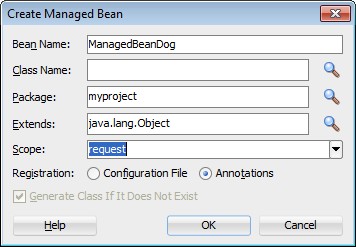JSF - (Managed Bean|Controller)
About
Managed Beans (also known as model objects and controllers) are lightweight container-managed objects (POJOs) with minimal requirements.
They support a small set of basic services, such as:
- lifecycle callbacks,
- and interceptors.
Components in a page are associated with managed beans that provide application logic. A managed bean is created with:
- a constructor with no arguments,
- a set of properties,
- and a set of methods that perform functions for a component.
Each of the managed bean properties can be bound to one of the following:
- A component value
- A component instance
- A converter instance
- A listener instance
- A validator instance
The most common functions that managed bean methods perform include the following:
- Validating a component’s data
- Handling an event fired by a component
- Performing processing to determine the next page to which the application must navigate
Articles Related
Registration
Annotation
- The @ManagedBean annotation registers the managed bean as a resource with the JavaServer Faces implementation. If no name is specified, the managed beans is always accessed with the first letter of the class name in lowercase.
- The @SessionScoped annotation registers the bean scope as session.
Configuration File
Scope
- Request
- Session
- Application
- View
- None
Property
In a managed bean, a property consists of:
- and a set of accessors methods.
package hello;
import javax.faces.bean.ManagedBean;
@ManagedBean
public class Hello {
final String world = "Hello World!";
public String getworld() {
return world;
}
}
When bound to a component’s value, a bean property can be any of the basic primitive and numeric types or any Java object type for which the application has access to an appropriate converter. For example, a property can be of type Date if the application has access to a converter that can convert the Date type to a String and back again.
